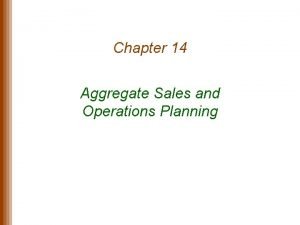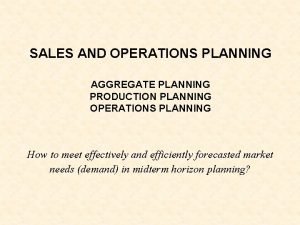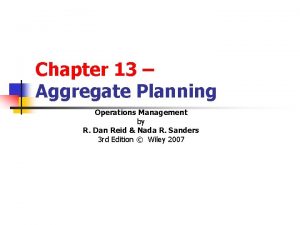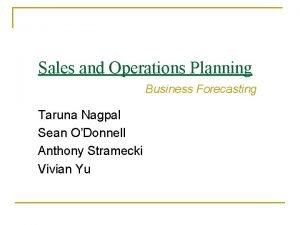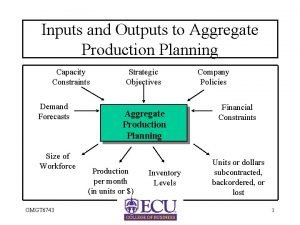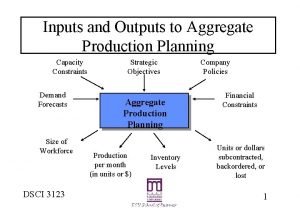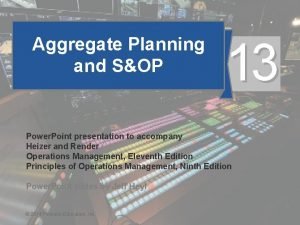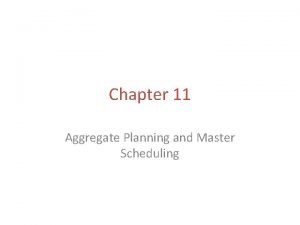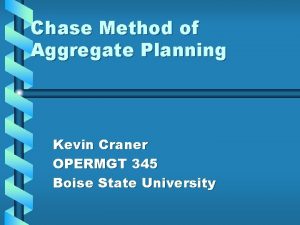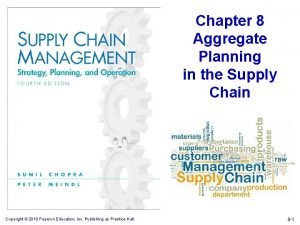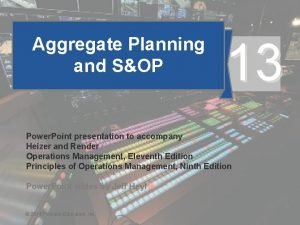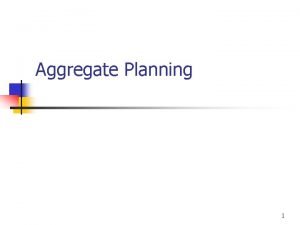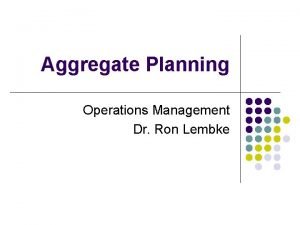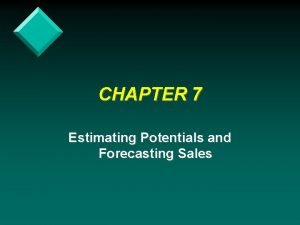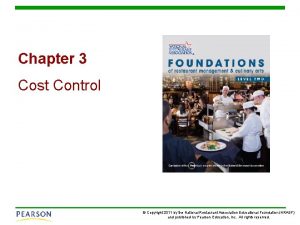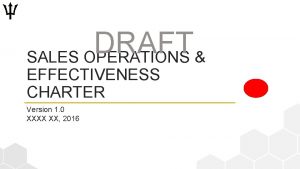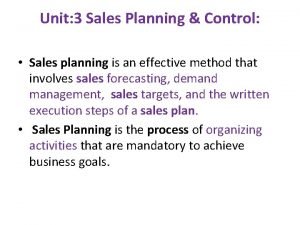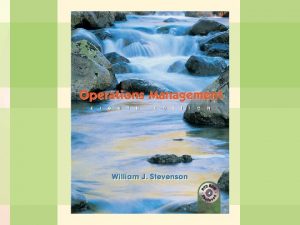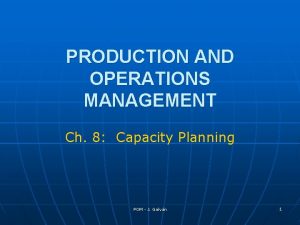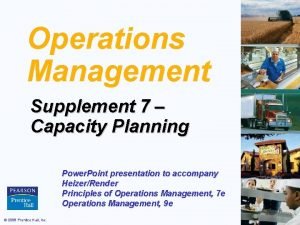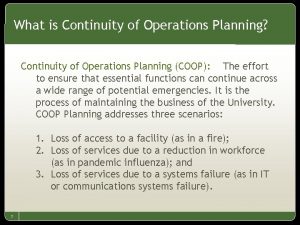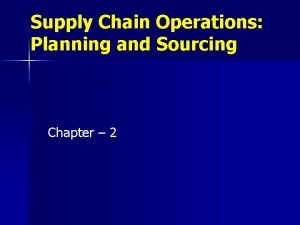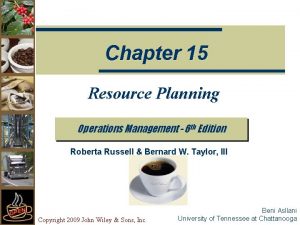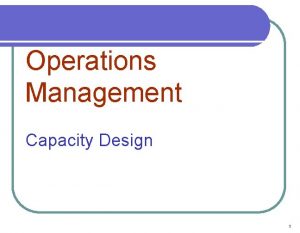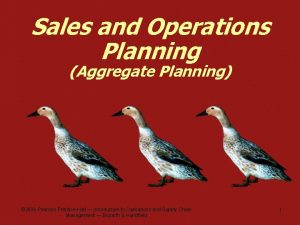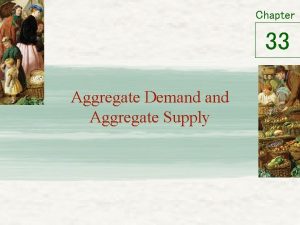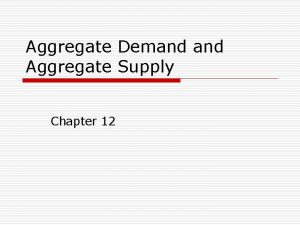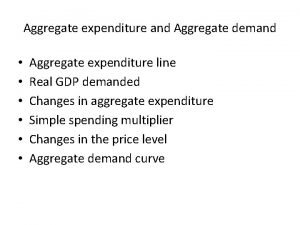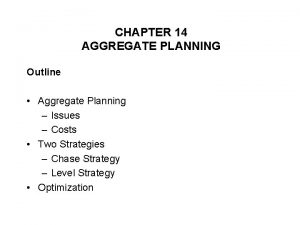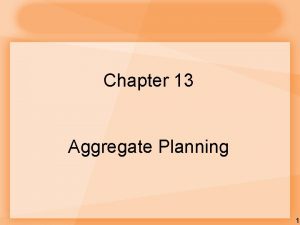Chapter 14 Aggregate Sales and Operations Planning Lecture



























































- Slides: 59

Chapter 14 Aggregate Sales and Operations Planning

Lecture Outline • • • The Sales and Operations Planning Process Strategies for Adjusting Capacity Strategies for Managing Demand Quantitative Techniques for Aggregate Planning Hierarchical Nature of Planning Aggregate Planning for Services Copyright 2011 John Wiley & Sons, Inc. 14 -2

Sales and Operations Planning • Determines resource capacity to meet demand over an intermediate time horizon • Aggregate refers to sales and operations planning for product lines or families • Sales and Operations planning (S&OP) matches supply and demand • Objectives • Establish a company wide plan for allocating resources • Develop an economic strategy for meeting demand Copyright 2011 John Wiley & Sons, Inc. 14 -3

Sales and Operations Planning Process Copyright 2011 John Wiley & Sons, Inc. 14 -4

Monthly S&OP Planning Process Copyright 2011 John Wiley & Sons, Inc. 14 -5

Meeting Demand Strategies • Adjusting capacity • Resources to meet demand are acquired and maintained over the time horizon of the plan • Minor variations in demand are handled with overtime or under-time • Managing demand • Proactive demand management Copyright 2011 John Wiley & Sons, Inc. 14 -6

Strategies for Adjusting Capacity • Level production • Producing at a constant rate and using inventory to absorb fluctuations in demand • Chase demand • Hiring and firing workers to match demand • Peak demand • Maintaining resources for high-demand levels Copyright 2011 John Wiley & Sons, Inc. 14 -7

Strategies for Adjusting Capacity • Overtime and under-time • Increase or decrease working hours • Subcontracting • Let outside companies complete the work • Part-time workers • Hire part-time workers to complete the work • Backordering • Provide the service or product at a later time period Copyright 2011 John Wiley & Sons, Inc. 14 -8

Level Production Units Demand Production Time Copyright 2011 John Wiley & Sons, Inc. 14 -9

Chase Demand Units Production Time Copyright 2011 John Wiley & Sons, Inc. 14 -10

Strategies for Managing Demand • Shifting demand into other time periods – Incentives – Sales promotions – Advertising campaigns • Offering products or services with counter-cyclical demand patterns • Partnering with suppliers to reduce information distortion along the supply chain Copyright 2011 John Wiley & Sons, Inc. 14 -11

Quantitative Techniques For AP • • • Pure Strategies Mixed Strategies Linear Programming Transportation Method Other Quantitative Techniques Copyright 2011 John Wiley & Sons, Inc. 14 -12

Pure Strategies QUARTER Spring Summer Fall Winter SALES FORECAST (LB) 80, 000 50, 000 120, 000 150, 000 Hiring cost = $100 per worker Firing cost = $500 per worker Inventory carrying cost = $0. 50 pound per quarter Regular production cost per pound = $2. 00 Production per employee = 1, 000 pounds per quarter Beginning work force = 100 workers Copyright 2011 John Wiley & Sons, Inc. 14 -13

Level Production Strategy Level production (50, 000 + 120, 000 + 150, 000 + 80, 000) = 100, 000 pounds 4 SALES PRODUCTION QUARTER FORECAST PLAN INVENTORY Spring 80, 000 100, 000 20, 000 Summer 50, 000 100, 000 70, 000 Fall 120, 000 100, 000 50, 000 Winter 150, 000 100, 000 0 400, 000 140, 000 Cost of Level Production Strategy (400, 000 X $2. 00) + (140, 00 X $. 50) = $870, 000 Copyright 2011 John Wiley & Sons, Inc. 14 -14

Chase Demand Strategy SALES PRODUCTION QUARTER FORECAST Spring 80, 000 Summer 50, 000 Fall 120, 000 Winter 150, 000 WORKERS PLAN NEEDED HIRED FIRED 80 0 50, 000 50 120, 000 150, 000 100 20 0 120 150 30 70 30 0 0 50 Cost of Chase Demand Strategy (400, 000 X $2. 00) + (100 x $100) + (50 x $500) = $835, 000 Copyright 2011 John Wiley & Sons, Inc. 14 -15

Level Production with Excel Cost of level production = inventory costs + production costs Input by user =400, 000/4 Copyright 2011 John Wiley & Sons, Inc. Inventory at end of summer 14 -16

Chase Demand with Excel No. of workers hired in fall Workforce requirements calculated by system Production input by user; production =demand Copyright 2011 John Wiley & Sons, Inc. Cost of chase demand = hiring + firing + production 14 -17

Mixed Strategy • Combination of Level Production and Chase Demand strategies • Example policies • no more than x% of workforce can be laid off in one quarter • inventory levels cannot exceed x dollars • Some industries may shut down manufacturing during the low demand season and schedule employee vacations during that time Copyright 2011 John Wiley & Sons, Inc. 14 -18

General Linear Programming (LP) Model • LP gives an optimal solution, but demand costs must be linear • Let • • • Wt = workforce size for period t Pt =units produced in period t It =units in inventory at the end of period t Ft =number of workers fired for period t Ht = number of workers hired for period t Copyright 2011 John Wiley & Sons, Inc. 14 -19

LP MODEL Minimize Z = $100 (H 1 + H 2 + H 3 + H 4) + $500 (F 1 + F 2 + F 3 + F 4) + $0. 50 (I 1 + I 2 + I 3 + I 4) + $2 (P 1 + P 2 + P 3 + P 4) Subject to Demand constraints Production constraints Work force constraints Copyright 2011 John Wiley & Sons, Inc. P 1 - I 1 = 80, 000(1) I 1 + P 2 - I 2 = 50, 000(2) I 2 + P 3 - I 3 = 120, 000 I 3 + P 4 - I 4 = 150, 000 (4) 1000 W 1 = P 1 (5) 1000 W 2 = P 2 (6) 1000 W 3 = P 3 (7) 1000 W 4 = P 4 (8) 100 + H 1 - F 1 = W 1 (9) W 1 + H 2 - F 2 = W 2 (10) W 2 + H 3 - F 3 = W 3 (11) W 3 + H 4 - F 4 = W 4 (12) (3) 14 -20

Setting up the Spreadsheet Target cell; cost of solution goes here Solver will put the solution here When model is complete, Solve Cells where solution appears Click here next Demand Constraint Production Constraint Workforce Constraint Copyright 2011 John Wiley & Sons, Inc. 14 -21

Setting up the Spreadsheet Click these boxes Copyright 2011 John Wiley & Sons, Inc. 14 -22

The LP Solution Cost of optimal solution Solution is a mix of inventory, hiring and firing Optimal production plan Copyright 2011 John Wiley & Sons, Inc. Extra report options 14 -23

Level Production for Quantum Cost of level production Excel calculates these Input by user Level = 12, 000/12 = 1, 000 Copyright 2011 John Wiley & Sons, Inc. 14 -24

Chase Demand for Quantum No. workers hired in Feb. Cost of chase demand Excel calculates these Input by user Copyright 2011 John Wiley & Sons, Inc. 14 -25

LP Solution for Quantum Optimal solution Constraint equations in these cells Solver found this solution Copyright 2011 John Wiley & Sons, Inc. 14 -26

Transportation Method EXPECTED REGULAR OVERTIME SUBCONTRACT QUARTER DEMAND CAPACITY 1 900 100 500 CAPACITY 2 3 4 1500 1600 3000 1200 1300 Regular production cost Overtime production cost Subcontracting cost Inventory holding cost Beginning inventory Copyright 2011 John Wiley & Sons, Inc. 150 200 500 500 $20/unit $25/unit $28/unit $3/unit-period 300 units 14 -27

Transportation Tableau Copyright 2011 John Wiley & Sons, Inc. 14 -28

Transportation Tableau Copyright 2011 John Wiley & Sons, Inc. 14 -29

Burruss’ Production Plan REGULAR PERIOD DEMAND PRODUCTION INVENTORY 1 2 3 4 Total 900 1500 1600 3000 7000 Copyright 2011 John Wiley & Sons, Inc. 1000 1200 1300 4800 150 200 650 SUBENDING OVERTIME CONTRACT 0 250 500 1250 500 600 1000 0 2100 14 -30

Excel and Transportation Method Period 2’s ending inventory Regular production for period 1 Cost of solution Copyright 2011 John Wiley & Sons, Inc. 14 -31

Other Quantitative Techniques • Linear decision rule (LDR) • Search decision rule (SDR) • Management coefficients model Copyright 2011 John Wiley & Sons, Inc. 14 -32

Hierarchical Nature of Planning Production Planning Capacity Planning Resource Level Product lines or families Sales and Operations Plan Resource requirements plan Plants Individual products Master production schedule Rough-cut capacity plan Critical work centers Components Material requirements plan Capacity requirements plan All work centers Shop floor schedule Input/ output control Items Manufacturing operations Copyright 2011 John Wiley & Sons, Inc. Individual machines 14 -33

Disaggregation • Breaking an aggregate plan into more detailed plans • Create Master Production Schedule for Material Requirements Planning Copyright 2011 John Wiley & Sons, Inc. 14 -34

Collaborative Planning • Sharing information and synchronizing production across supply chain • Part of CPFR (collaborative planning, forecasting, and replenishment) • involves selecting products to be jointly managed, creating a single forecast of customer demand, and synchronizing production across supply chain Copyright 2011 John Wiley & Sons, Inc. 14 -35

Available-to-Promise (ATP) • Quantity of items that can be promised to customer • Difference between planned production and customer orders already received AT in period 1 = (On-hand quantity + MPS in period 1) – (CO until the next period of planned production) ATP in period n = (MPS in period n) – (CO until the next period of planned production) • Capable-to-promise • quantity of items that can be produced and mad available at a later date Copyright 2011 John Wiley & Sons, Inc. 14 -36

ATP Copyright 2011 John Wiley & Sons, Inc. 14 -37

ATP Copyright 2011 John Wiley & Sons, Inc. 14 -38

ATP Take excess units from April ATP in April = (10+100) – 70 = 40 ATP in May = 100 – 110 = -10 ATP in June = 100 – 50 = 50 Copyright 2011 John Wiley & Sons, Inc. = 30 =0 14 -39

Rule Based ATP Product Request Yes Is the product available at this location? No Available-topromise Yes Is an alternative product available at this location? No Allocate inventory Yes Is this product available at a different location? No Copyright 2011 John Wiley & Sons, Inc. Is an alternative product available at an alternate location? Yes No Capable-topromise date Is the customer willing Yes to wait for the product? No Available-topromise Allocate inventory Revise master schedule Trigger production Lose sale 14 -40

Aggregate Planning for Services • • Most services cannot be inventoried Demand for services is difficult to predict Capacity is also difficult to predict Service capacity must be provided at the appropriate place and time • Labor is usually the most constraining resource for services Copyright 2011 John Wiley & Sons, Inc. 14 -41

Yield Management Copyright 2011 John Wiley & Sons, Inc. 14 -42

Yield Management Copyright 2011 John Wiley & Sons, Inc. 14 -43

Yield Management NO-SHOWS PROBABILITY P(N < X) 0 1 2 3 . 00. 15. 40. 70 . 15. 25. 30 . 517 Optimal probability of no-shows P(n < x) Cu 75 = =. 517 Cu + Co 75 + 70 Hotel should be overbooked by two rooms Copyright 2011 John Wiley & Sons, Inc. 14 -44

Chapter 14 Supplement Linear Programming Decision Analysis Tools and Techniques

Lecture Outline • Model Formulation • Linear Programming Model Solution • Solving Linear Programming Problems with Excel • Sensitivity Analysis Copyright 2011 John Wiley & Sons, Inc. Supplement 14 -46

Linear Programming (LP) • A model consisting of linear relationships representing a firm’s objective and resource constraints • A mathematical modeling technique which determines a level of operational activity in order to achieve an objective, subject to restrictions called constraints Copyright 2011 John Wiley & Sons, Inc. Supplement 14 -47

Types of LP Copyright 2011 John Wiley & Sons, Inc. Supplement 14 -48

Types of LP Copyright 2011 John Wiley & Sons, Inc. Supplement 14 -49

Types of LP Copyright 2011 John Wiley & Sons, Inc. Supplement 14 -50

LP Model Formulation • Decision variables • symbols representing levels of activity of an operation • Objective function • linear relationship for the objective of an operation • most frequent business objective is to maximize profit • most frequent objective of individual operational units (such as a production or packaging department) is to minimize cost • Constraint • linear relationship representing a restriction on decision making Copyright 2011 John Wiley & Sons, Inc. Supplement 14 -51

LP Model Formulation Max/min z = c 1 x 1 + c 2 x 2 +. . . + cnxn subject to: Constraints a 11 x 1 + a 12 x 2 +. . . + a 1 nxn (≤, =, ≥) b 1 a 21 x 1 + a 22 x 2 +. . . + a 2 nxn (≤, =, ≥) b 2 : an 1 x 1 + an 2 x 2 +. . . + annxn (≤, =, ≥) bn xj = decision variables bi = constraint levels cj = objective function coefficients aij = constraint coefficients Copyright 2011 John Wiley & Sons, Inc. Supplement 14 -52

Highlands Craft Store Resource Requirements Labor Clay Revenue Product (hr/unit) (lb/unit) ($/unit) Bowl 1 4 40 Mug 2 3 50 There are 40 hours of labor and 120 pounds of clay available each day Decision variables x 1 = number of bowls to produce x 2 = number of mugs to produce Copyright 2011 John Wiley & Sons, Inc. Supplement 14 -53

Highlands Craft Store Maximize Z = $40 x 1 + 50 x 2 Subject to x 1 constraint) 4 x 1 constraint) + 2 x 2 40 hr (labor + 3 x 2 120 lb (clay x 1 , x 2 0 Solution is x 1 = 24 bowls Revenue = $1, 360 Copyright 2011 John Wiley & Sons, Inc. x 2 = 8 mugs Supplement 14 -54

Simplex Method • Mathematical procedure for solving LP problems • Follow a set of steps to reach optimal solution • Slack variables added to ≤ constraints to represent unused resources • x 1 + 2 x 2 + s 1 = 40 hours of labor • 4 x 1 + 3 x 2 + s 2 = 120 lb of clay • Surplus variables subtracted from ≥ constraints to represent excess above resource requirement. • 2 x 1 + 4 x 2 ≥ 16 is transformed into • 2 x 1 + 4 x 2 - s 1 = 16 • Slack/surplus variables have a 0 coefficient in the objective function • Z = $40 x 1 + $50 x 2 + 0 s 1 + 0 s 2 Copyright 2011 John Wiley & Sons, Inc. Supplement 14 -55

Solving LP Problems with Excel Click on “Data” to invoke “Solver” Objective function =C 6*B 10+D 6*B 11 =E 6 -F 6 =E 7 -F 7 Decision variables bowls (X 1) = B 10 mugs (x 2) = B 11 Copyright 2011 John Wiley & Sons, Inc. =C 7*B 10+D 7*B 11 Supplement 14 -56

Solving LP Problems with Excel After all parameters and constraints have been input, click on “Solve” Objective function Decision variables C 6*B 10+D 6*B 11≤ 40 and C 7*B 10+D 7*B 11≤ 120 Click on “Add” to insert constraints Click on “Options” to add non-negativity and linear conditions Copyright 2011 John Wiley & Sons, Inc. Supplement 14 -57

LP Solution Copyright 2011 John Wiley & Sons, Inc. Supplement 14 -58

Sensitivity Analysis Sensitivity range for labor; 30 to 80 lbs. Shadow prices – marginal values – for labor and clay. Copyright 2011 John Wiley & Sons, Inc. Sensitivity range for clay; 60 to 160 lbs. Supplement 14 -59
 Aggregate planning excel solver
Aggregate planning excel solver Aggregate sales and operations planning
Aggregate sales and operations planning Sras lras
Sras lras What is aggregate planning in operations management
What is aggregate planning in operations management Aggregate demand and aggregate supply
Aggregate demand and aggregate supply Cannot mix aggregate and non aggregate tableau
Cannot mix aggregate and non aggregate tableau Unit 3 aggregate demand aggregate supply and fiscal policy
Unit 3 aggregate demand aggregate supply and fiscal policy Unit 3 aggregate demand aggregate supply and fiscal policy
Unit 3 aggregate demand aggregate supply and fiscal policy Unit 3 aggregate demand aggregate supply and fiscal policy
Unit 3 aggregate demand aggregate supply and fiscal policy Perencanaan agregat
Perencanaan agregat Aggregate capacity planning
Aggregate capacity planning Aggregate planning is capacity planning for
Aggregate planning is capacity planning for Sap s&op
Sap s&op Rough cut capacity planning example
Rough cut capacity planning example Level strategy production planning
Level strategy production planning Aggregate production planning example
Aggregate production planning example Inputs of aggregate planning
Inputs of aggregate planning S&op ppt
S&op ppt Disaggregating the aggregate plan
Disaggregating the aggregate plan 01:640:244 lecture notes - lecture 15: plat, idah, farad
01:640:244 lecture notes - lecture 15: plat, idah, farad Territorial sales force structure example
Territorial sales force structure example Discuss the nuances of sales letters.
Discuss the nuances of sales letters. Ales force structure
Ales force structure Clover leaf routing plan
Clover leaf routing plan Chase strategy example
Chase strategy example Chase production method
Chase production method What is aggregate planning in supply chain
What is aggregate planning in supply chain Aggregate planning objectives
Aggregate planning objectives Aggregate planning formula
Aggregate planning formula Graphical method of aggregate planning
Graphical method of aggregate planning Aggregate planning
Aggregate planning Role of aggregate planning
Role of aggregate planning Aggregate planning template
Aggregate planning template Types of plans in management
Types of plans in management Om306
Om306 Project planning and management lecture notes ppt
Project planning and management lecture notes ppt Sales potential vs sales forecast
Sales potential vs sales forecast Which is the primary sales tool in most operations?
Which is the primary sales tool in most operations? Sales operations organizational structure
Sales operations organizational structure Sales budget
Sales budget Land use planning lecture notes
Land use planning lecture notes Land economics lecture notes
Land economics lecture notes Land use planning '' lecture notes
Land use planning '' lecture notes Enterprise resource planning lecture notes ppt
Enterprise resource planning lecture notes ppt Location planning in operations management
Location planning in operations management Strategic retail management
Strategic retail management Aggregate of chapter 6
Aggregate of chapter 6 What shifts aggregate supply to the left
What shifts aggregate supply to the left Aggregate of chapter 6
Aggregate of chapter 6 Sales call steps
Sales call steps Planned capacity
Planned capacity Leading demand with incremental expansion
Leading demand with incremental expansion Continuity of operations plan definition
Continuity of operations plan definition Mrp in operations management
Mrp in operations management Supply chain operations planning
Supply chain operations planning Location planning management
Location planning management Resource planning in operations management
Resource planning in operations management Design capacity in operations management
Design capacity in operations management Inactivism planning
Inactivism planning Short medium and long term planning in education
Short medium and long term planning in education
